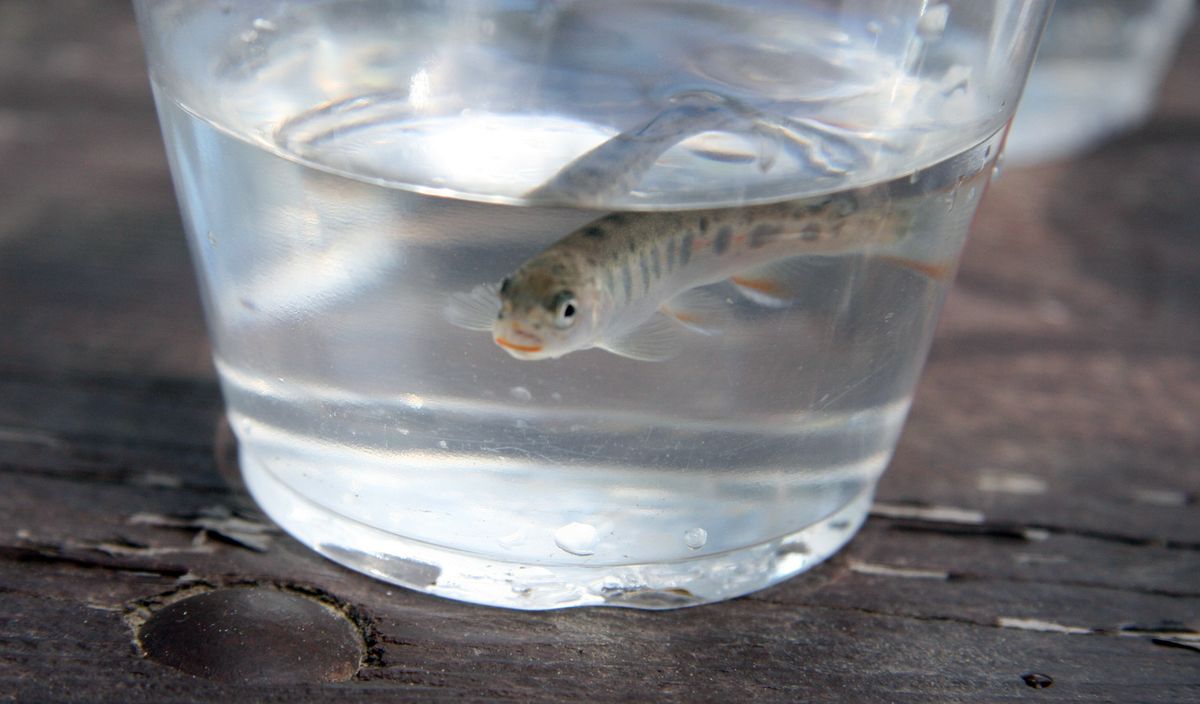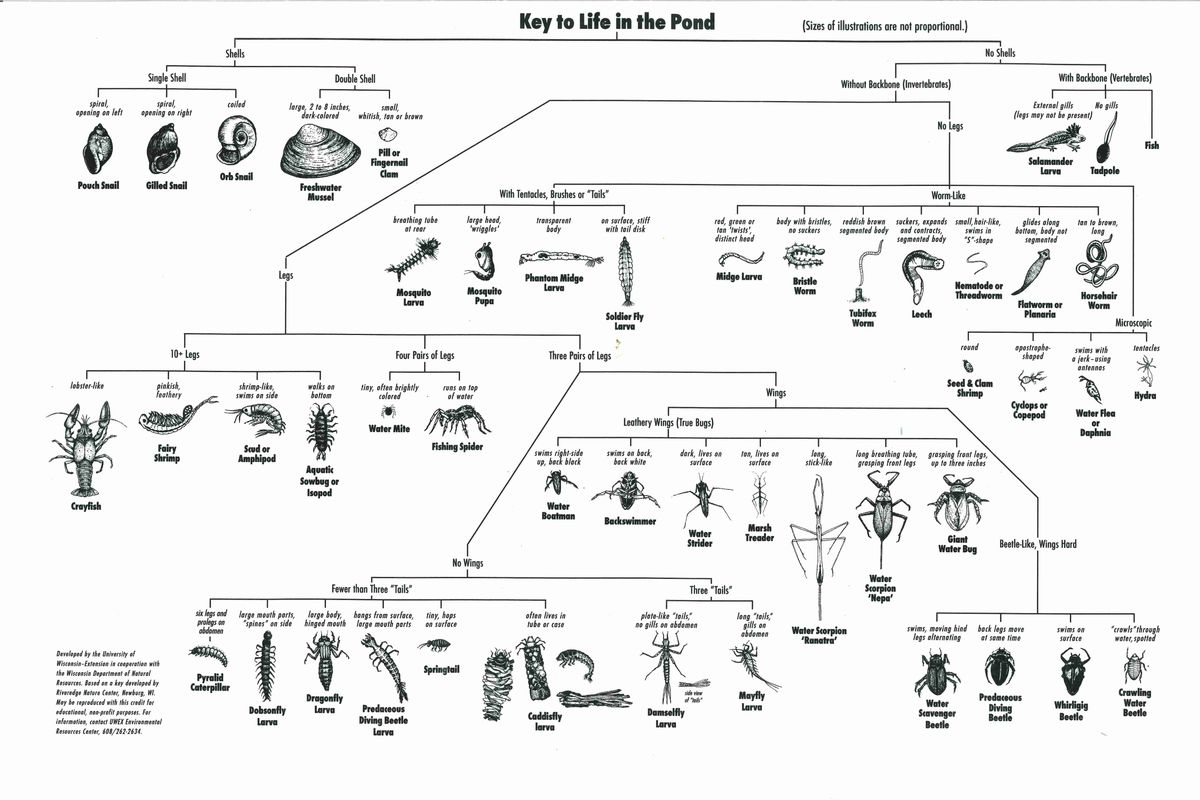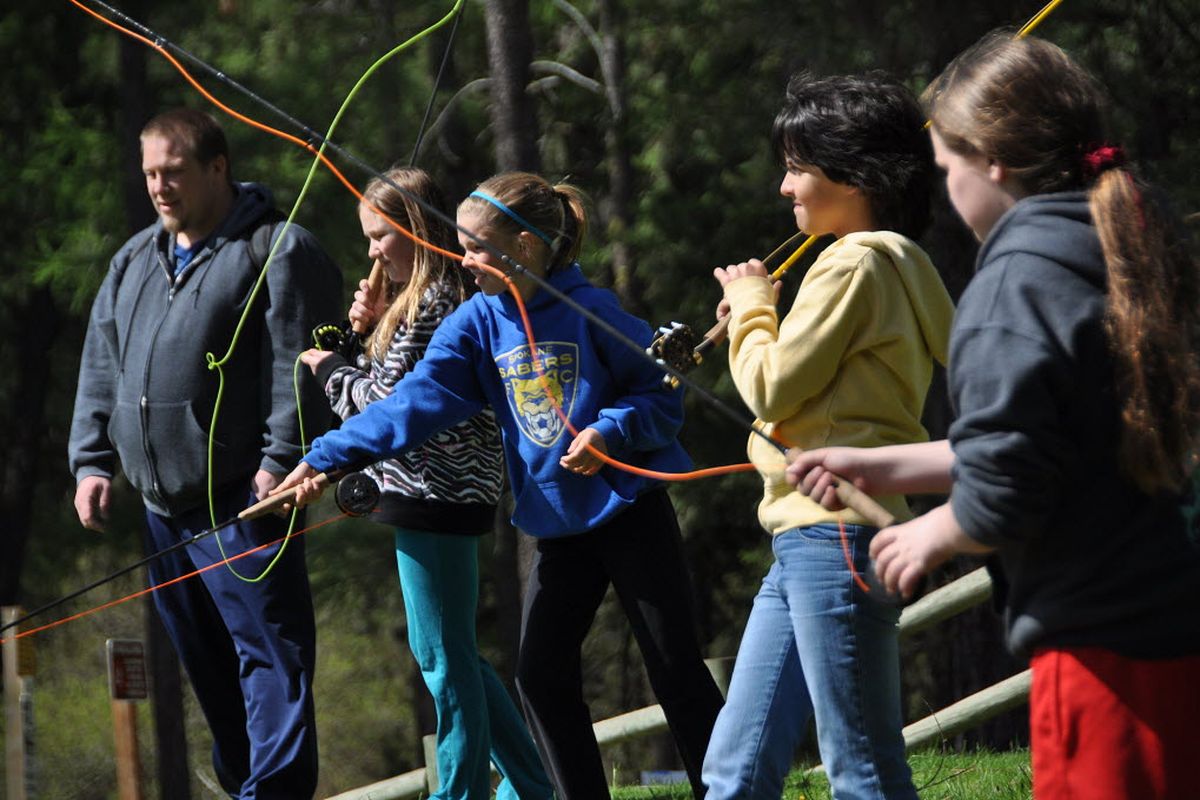Curriculum hooks up with Trout in the Classroom
Students in the Trout in the Classroom program at area elementary schools used this macroinvertebrate chart to identify aquatic insects, shellfish and other critters that might be found in a bucket of water, sediment and weeds scooped off shore at Bear Lake.
Trout are spawning a watershed of educational opportunities for Spokane County kids.
A thousand fertilized rainbow eggs divvied out to 10 elementary schools have hatched a semester of lessons in reading, writing, math and science, said Stacey Selcho, Spokane Conservation District education coordinator.
Selcho helps organize the Trout in the Classroom program initiated with a grant and expertise from Trout Unlimited.
The program outfits schools who have science teachers willing to turn a corner of their rooms into a small-fry fish hatchery.
Each school raises 100 eggs provided by the Washington Fish and Wildlife Department’s Spokane Fish Hatchery. Students monitor tank water quality and other science-related lessons energized by the excitement of seeing the trout develop.
Eye-stage eggs delivered to the schools in January incubate in the flowing water of the fish tanks. Students use eye-droppers to pluck out any dead eggs to prevent fungus from spreading in the tanks.
The students can keep nearly nose-to-nose tabs on the fish as they hatch, absorb their yolk sacs and develop into frisky fingerlings.
The effort is culminated with the Trout Turnout, which occurred the last week of April at Liberty Lake and Bear Lake.
“It costs about $1,300 to outfit a classroom, and that’s a good investment,” said Mike Keegan, Spokane Fly Fishers conservation chairman.
“We’d like to involve more of the community and expand the program,” said Bill Abrahamse, Trout Unlimited’s Spokane Falls Chapter president.
TU and other area fly fishing groups contribute to the program with money and members who were at the “turnouts” for the final trout-inspired lessons of the year.
Students from each school rotated from station to station for presentations by various agencies and groups on subjects ranging from bugs to watershed ecosystems.
Schools at the Bear Lake event included Farwell Elementary, Loon Lake, Reardan, Valley, St. George’s, Tekoa, South Pines, Liberty and Freeman.
The fifth- and sixth-grade students were especially keen for the long-anticipated keynote activity: releasing the trout they had raised in their schools.
Volunteers dipped fingerlings from the tanks each school brought to the outing and put them in individual cups of water. Each student was able to release a fish into the lake.
“One of the classes came with only eight fish out of 100 eggs and a small class from another school had 80 fish, so they all shared,” said Abrahamse. “That was pretty neat.”
“Overall, they have good success rates, bringing 80-100 percent of the eggs to fingerlings,” Selcho said. “Except in a couple of cases when the chiller units failed on the tanks.”
Even that was a learning experience, she said: Without cool water, trout die.
But the kids clearly relished seeing their survivors swim to freedom in the lake.
“My daughter didn’t have much trouble with the fact that the fish she released might be eaten by another fish,” said Mike Poutiatine, father of a St. George’s sixth-grader. “But she was a little concerned that it might be hooked by a fisherman. She’s still processing that.”
Maybe her concerns were cast away when she lined up at the fly-casting station run by the local fly fishing club members.
The action clearly was foreign to most of the students. The fly rods didn’t work like a “real” fishing rod, and they didn’t quite work like a good whip, either.
But every now and then, one of them rolled out a picturesque loop of line that made their instructor beam.
Mac Mikkelsen, Avista’s hydro safety coordinator, worked a Hydro simulator at his station to illustrate reservoir management. The device showed how reservoirs provide electrical power generation during drawdowns for spring runoff and while storing water for power – as well as fish and recreation – dry months.
And every kid who went through Mikkelsen’s station should know a gallon of water weighs 8.2 pounds.
A barn owl perched kept the students’ attention while Darlea Chatburn of the West Valley Outdoor Learning Center explained birds of prey and their role in the environment.
Wheat from farm to table was explained by Kara Kaelber of Franklin Conservation District while kids made trout lifecycle bracelets at another conservation district station.
Nicole Parish of The Lands Council tied several watershed lessons together with an “enviroscape” to show how water flows and is absorbed – or not absorbed – in a watershed.
Pavement forces water that otherwise would go in to the ground to go into storm water drains, she said. Drops of oil scattered on the countless acres of asphalt can have a significant cumulative effect on major waterways – and the trout that live in them.
Her talk also touched on stream ecology and how busy beavers naturally enhance the landscape’s ability to store and provide cool water for fish.
Nothing riveted the students’ attention as firmly as the basins of water Brook Beeler had scooped from the lake shore with just enough sediment and aquatic vegetation to harbor the eclectic cast at lower levels of the food chain.
Kids squished together over the basins in team efforts using turkey basters to suck up, isolate and identify anything that looked alive among the debris.
Students were totally absorbed in the discovery and the learning as they tried to match benthic bugs to the illustrated charts on the table.
Prize finds included leeches and dragonfly and damselfly nymphs.
Some observant kids remarked at the scary-looking chops on a dragonfly nymph. But to a trout, that’s the look of a good meal.
Invertebrates can be “canaries in the bird cage” of a lake, said Beeler, Washington Department of Ecology watershed education coordinator.
“What these kids are learning goes way beyond watershed education,” Selcho said. “The fish provide a real-life, hands-on science opportunity.
“Every school approaches it differently. South Pines fifth-graders learn the life cycles of the trout then teach the lessons to the first-graders.”
Of course, some of the students will become anglers. And with a little luck, the stewardship of the volunteer fly fishers will rub off.
During the Trout Turnout lunch break, the TU and fly fishing club members could be heard talking about matching fly patterns to the invertebrates they saw along the lake shore.
They talked about fishing trips they planned for spring and summer.
And the turnout wasn’t the last volunteer conservation project they’d scheduled for the season.
“We’ll be fin-clipping young trout (for research) at the Spokane Hatchery,” Keegan said. “We’ll be planting trees for the Colville National Forest to improve water quality in Calispell Creek,” he added, noting the club also has a fence-building session to steer cattle out of mountain streams to reduce shoreline erosion.
These are good guys to have on a science teacher’s team.



